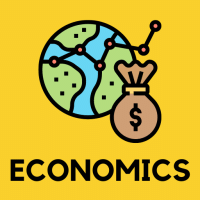Commerce Exam > Commerce Questions > There is always an ideal factor ratio. What h...
Start Learning for Free
There is always an ideal factor ratio. What happens if this ideal ratio is crossesd. Related Economic class 12.?
Most Upvoted Answer
There is always an ideal factor ratio. What happens if this ideal rati...
If the ideal factor ratio is crossed, diminishing returns to a factor srt in. MP of the variable factor starts declining. TP increase only at a decreasing rate.
Community Answer
There is always an ideal factor ratio. What happens if this ideal rati...
Impact of Deviation from Ideal Factor Ratio on Production
The ideal factor ratio refers to the optimal combination of labor and capital needed to produce goods and services efficiently. It is the ratio that maximizes the output for a given level of input. However, in some cases, the ideal factor ratio may be disturbed, resulting in either a labor-intensive or capital-intensive production process.
Impact of Labor-Intensive Production
When the factor ratio becomes labor-intensive, it means that the production process requires more labor than capital. This may happen due to a shortage of capital or a surplus of labor. The following are some of the impacts of labor-intensive production:
1. Low productivity: Since labor is the dominant factor, the productivity of the production process may be low. This is because labor may not be able to manage the capital effectively, leading to inefficiencies and waste.
2. High labor cost: Labor-intensive production may result in a high labor cost since more labor is needed to produce a unit of output. This may lead to higher costs of production and reduced profitability.
3. Poor quality: Due to the high labor cost, producers may resort to using cheap labor, which may result in poor quality products. This may affect the marketability and competitiveness of the products.
Impact of Capital-Intensive Production
When the factor ratio becomes capital-intensive, it means that the production process requires more capital than labor. This may happen due to a surplus of capital or a shortage of labor. The following are some of the impacts of capital-intensive production:
1. High productivity: Since capital is the dominant factor, the productivity of the production process may be high. This is because capital can substitute for labor, leading to efficient production.
2. High capital cost: Capital-intensive production may result in a high capital cost since more capital is needed to produce a unit of output. This may lead to higher costs of production and reduced profitability.
3. Unemployment: Capital-intensive production may lead to unemployment since fewer workers are needed. This may have a negative impact on the economy since unemployment may lead to reduced consumption and investment.
In conclusion, the deviation from the ideal factor ratio may have significant impacts on the production process and the economy at large. It is, therefore, important for producers to strive to achieve the optimal factor ratio to maximize output and profitability.
The ideal factor ratio refers to the optimal combination of labor and capital needed to produce goods and services efficiently. It is the ratio that maximizes the output for a given level of input. However, in some cases, the ideal factor ratio may be disturbed, resulting in either a labor-intensive or capital-intensive production process.
Impact of Labor-Intensive Production
When the factor ratio becomes labor-intensive, it means that the production process requires more labor than capital. This may happen due to a shortage of capital or a surplus of labor. The following are some of the impacts of labor-intensive production:
1. Low productivity: Since labor is the dominant factor, the productivity of the production process may be low. This is because labor may not be able to manage the capital effectively, leading to inefficiencies and waste.
2. High labor cost: Labor-intensive production may result in a high labor cost since more labor is needed to produce a unit of output. This may lead to higher costs of production and reduced profitability.
3. Poor quality: Due to the high labor cost, producers may resort to using cheap labor, which may result in poor quality products. This may affect the marketability and competitiveness of the products.
Impact of Capital-Intensive Production
When the factor ratio becomes capital-intensive, it means that the production process requires more capital than labor. This may happen due to a surplus of capital or a shortage of labor. The following are some of the impacts of capital-intensive production:
1. High productivity: Since capital is the dominant factor, the productivity of the production process may be high. This is because capital can substitute for labor, leading to efficient production.
2. High capital cost: Capital-intensive production may result in a high capital cost since more capital is needed to produce a unit of output. This may lead to higher costs of production and reduced profitability.
3. Unemployment: Capital-intensive production may lead to unemployment since fewer workers are needed. This may have a negative impact on the economy since unemployment may lead to reduced consumption and investment.
In conclusion, the deviation from the ideal factor ratio may have significant impacts on the production process and the economy at large. It is, therefore, important for producers to strive to achieve the optimal factor ratio to maximize output and profitability.

|
Explore Courses for Commerce exam
|

|
Similar Commerce Doubts
There is always an ideal factor ratio. What happens if this ideal ratio is crossesd. Related Economic class 12.?
Question Description
There is always an ideal factor ratio. What happens if this ideal ratio is crossesd. Related Economic class 12.? for Commerce 2025 is part of Commerce preparation. The Question and answers have been prepared according to the Commerce exam syllabus. Information about There is always an ideal factor ratio. What happens if this ideal ratio is crossesd. Related Economic class 12.? covers all topics & solutions for Commerce 2025 Exam. Find important definitions, questions, meanings, examples, exercises and tests below for There is always an ideal factor ratio. What happens if this ideal ratio is crossesd. Related Economic class 12.?.
There is always an ideal factor ratio. What happens if this ideal ratio is crossesd. Related Economic class 12.? for Commerce 2025 is part of Commerce preparation. The Question and answers have been prepared according to the Commerce exam syllabus. Information about There is always an ideal factor ratio. What happens if this ideal ratio is crossesd. Related Economic class 12.? covers all topics & solutions for Commerce 2025 Exam. Find important definitions, questions, meanings, examples, exercises and tests below for There is always an ideal factor ratio. What happens if this ideal ratio is crossesd. Related Economic class 12.?.
Solutions for There is always an ideal factor ratio. What happens if this ideal ratio is crossesd. Related Economic class 12.? in English & in Hindi are available as part of our courses for Commerce.
Download more important topics, notes, lectures and mock test series for Commerce Exam by signing up for free.
Here you can find the meaning of There is always an ideal factor ratio. What happens if this ideal ratio is crossesd. Related Economic class 12.? defined & explained in the simplest way possible. Besides giving the explanation of
There is always an ideal factor ratio. What happens if this ideal ratio is crossesd. Related Economic class 12.?, a detailed solution for There is always an ideal factor ratio. What happens if this ideal ratio is crossesd. Related Economic class 12.? has been provided alongside types of There is always an ideal factor ratio. What happens if this ideal ratio is crossesd. Related Economic class 12.? theory, EduRev gives you an
ample number of questions to practice There is always an ideal factor ratio. What happens if this ideal ratio is crossesd. Related Economic class 12.? tests, examples and also practice Commerce tests.

|
Explore Courses for Commerce exam
|

|
Signup for Free!
Signup to see your scores go up within 7 days! Learn & Practice with 1000+ FREE Notes, Videos & Tests.
























